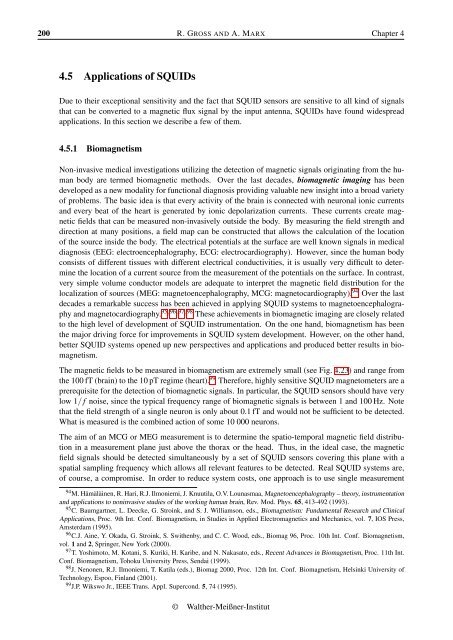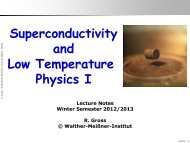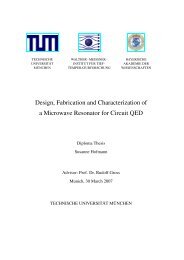Applied Superconductivity - Walther Meißner Institut - Bayerische ...
Applied Superconductivity - Walther Meißner Institut - Bayerische ...
Applied Superconductivity - Walther Meißner Institut - Bayerische ...
- No tags were found...
You also want an ePaper? Increase the reach of your titles
YUMPU automatically turns print PDFs into web optimized ePapers that Google loves.
200 R. GROSS AND A. MARX Chapter 44.5 Applications of SQUIDsDue to their exceptional sensitivity and the fact that SQUID sensors are sensitive to all kind of signalsthat can be converted to a magnetic flux signal by the input antenna, SQUIDs have found widespreadapplications. In this section we describe a few of them.4.5.1 BiomagnetismNon-invasive medical investigations utilizing the detection of magnetic signals originating from the humanbody are termed biomagnetic methods. Over the last decades, biomagnetic imaging has beendeveloped as a new modality for functional diagnosis providing valuable new insight into a broad varietyof problems. The basic idea is that every activity of the brain is connected with neuronal ionic currentsand every beat of the heart is generated by ionic depolarization currents. These currents create magneticfields that can be measured non-invasively outside the body. By measuring the field strength anddirection at many positions, a field map can be constructed that allows the calculation of the locationof the source inside the body. The electrical potentials at the surface are well known signals in medicaldiagnosis (EEG: electroencephalography, ECG: electrocardiography). However, since the human bodyconsists of different tissues with different electrical conductivities, it is usually very difficult to determinethe location of a current source from the measurement of the potentials on the surface. In contrast,very simple volume conductor models are adequate to interpret the magnetic field distribution for thelocalization of sources (MEG: magnetoencephalography, MCG: magnetocardiography). 94 Over the lastdecades a remarkable success has been achieved in applying SQUID systems to magnetoencephalographyand magnetocardiography. 95,96,97,98 These achievements in biomagnetic imaging are closely relatedto the high level of development of SQUID instrumentation. On the one hand, biomagnetism has beenthe major driving force for improvements in SQUID system development. However, on the other hand,better SQUID systems opened up new perspectives and applications and produced better results in biomagnetism.The magnetic fields to be measured in biomagnetism are extremely small (see Fig. 4.23) and range fromthe 100 fT (brain) to the 10 pT regime (heart). 99 Therefore, highly sensitive SQUID magnetometers are aprerequisite for the detection of biomagnetic signals. In particular, the SQUID sensors should have verylow 1/ f noise, since the typical frequency range of biomagnetic signals is between 1 and 100 Hz. Notethat the field strength of a single neuron is only about 0.1 fT and would not be sufficient to be detected.What is measured is the combined action of some 10 000 neurons.The aim of an MCG or MEG measurement is to determine the spatio-temporal magnetic field distributionin a measurement plane just above the thorax or the head. Thus, in the ideal case, the magneticfield signals should be detected simultaneously by a set of SQUID sensors covering this plane with aspatial sampling frequency which allows all relevant features to be detected. Real SQUID systems are,of course, a compromise. In order to reduce system costs, one approach is to use single measurement94 M. Hämäläinen, R. Hari, R.J. Ilmoniemi, J. Knuutila, O.V. Lounasmaa, Magnetoencephalography – theory, instrumentationand applications to noninvasive studies of the working human brain, Rev. Mod. Phys. 65, 413-492 (1993).95 C. Baumgartner, L. Deecke, G. Stroink, and S. J. Williamson, eds., Biomagnetism: Fundamental Research and ClinicalApplications, Proc. 9th Int. Conf. Biomagnetism, in Studies in <strong>Applied</strong> Electromagnetics and Mechanics, vol. 7, IOS Press,Amsterdam (1995).96 C.J. Aine, Y. Okada, G. Stroink, S. Swithenby, and C. C. Wood, eds., Biomag 96, Proc. 10th Int. Conf. Biomagnetism,vol. 1 and 2, Springer, New York (2000).97 T. Yoshimoto, M. Kotani, S. Kuriki, H. Karibe, and N. Nakasato, eds., Recent Advances in Biomagnetism, Proc. 11th Int.Conf. Biomagnetism, Tohoku University Press, Sendai (1999).98 J. Nenonen, R.J. Ilmoniemi, T. Katila (eds.), Biomag 2000, Proc. 12th Int. Conf. Biomagnetism, Helsinki University ofTechnology, Espoo, Finland (2001).99 J.P. Wikswo Jr., IEEE Trans. Appl. Supercond. 5, 74 (1995).© <strong>Walther</strong>-Meißner-<strong>Institut</strong>
















